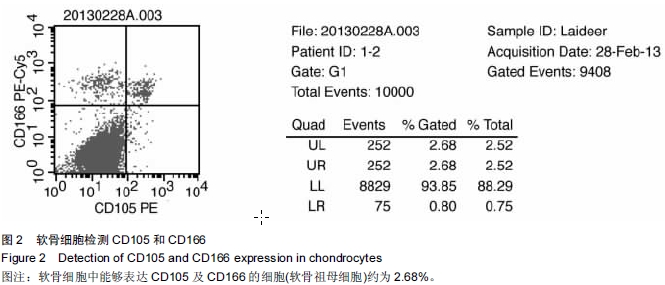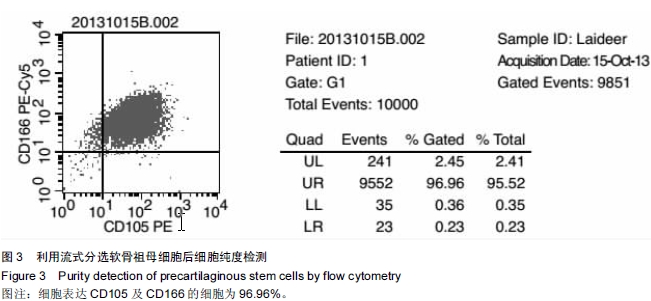| [1] Lawrence RC,Felson DT,Helmick CG,et al.Estimates of the prevalence of arthritis and other rheumatic conditions in the United States.Part II.Arthritis Rheum.2008;58(1):26-35.
[2] Reddi AH.Aging,osteoarthritis and transforming growth factor-beta signaling in cartilage.Arthritis Res Ther. 2006; 8(1):101.
[3] Fickert S,Fiedler J,Brenner RE.Identification of subpopulations with characteristics of mesenchymal progenitor cells from human osteoarthritic cartilage using triple staining for cell surface markers.Arthritis Res Ther. 2004;6(5):R422-432.
[4] Chen MH,Lin S,Hsieh CH,et al.Identification and initial characterization of small cells in adult cartilage and bone marrow.J Formos Med Assoc.2004;103(4):264-273.
[5] 陈跃平,董盼锋,章晓云,等.人类软骨糖蛋白39对成人膝关节软骨祖母细胞增殖的影响[J].山东医药,2015,55(1):1-4.
[6] 方锐,艾力江•阿斯拉,卢勇,等.兔骨性关节炎模型构建及早中晚期的特点[J].中国组织工程与临床康复,2010,14(7):1218-1222.
[7] 陈海南.骨性关节炎软骨下骨三维结构和力学性能改变及早期干预的实验研究[D].苏州:苏州大学,2013:22.
[8] 林戈,卢光琇.干细胞概述[J].生命科学,2006,18(4):313-317.
[9] 谭篆丽.干细胞研究与应用的伦理思考[D].天津:天津医科大学, 2013:1-40.
[10] Erices A,Conget P,Minguell JJ.Mesenchymal progenitor cells in human umbilical cord blood.Br J Haematol.2000;109(1):235-242.
[11] Armstrong RJ,Svendsen CN.Neural stem cells:from cell biology to cell replacement.Cell Transplant.2000;9:139-152.
[12] Marinova-Mutafchieva L, Taylor P, Funa K, et al. Mesenchymalcells expressing bone morphogenetic protein receptors are present in the rheumatoid arthritis joint.Arthritis Rheum.2000;43(9):2046-2055.
[13] De Bari C,Dell,Accio F,Tylzanowski P,et al.Multipotent mesenchymal stem cells from adult human synovial membrane. Arthritis Rheum.2001;44(8):1928-1942.
[14] Alsalameh S,Amin R,Gemba T,et al.Identification of Mesenchymal Progenitorcel-ls in Normal and Osteoarthritic Human Articular Cartilage.Arthritis Rheum.2004;50(5): 1522-1532.
[15] 王敏,Peter Chen,刘超,等.早期兔关节炎软骨CD105+/CD166+细胞及其软骨分化潜能的实验研究[J].中国修复重建外科杂志, 2013,27(7):793-799.
[16] 石福鑫,曹慧,徐婓,等.不同来源Ⅱ型胶原结构及其免疫活性[J].食品与发酵工业,2014,40(2):22-26.
[17] Kuo SM,Chiang MY,Lan CW,et al.Evaluation of nanoarchitectured collagen type II molecules on cartilage engineering.J Biomed Mater Res A.2013;101(2): 368-377.
[18] 罗二梅,宇丽,张家文,等.还原型谷胱甘肽对人脐带间充质干细胞成软骨诱导的影响[J].中国生物工程杂志,2013,33(3):1-8.
[19] 陈竹生,童心明,刘斌,等.细胞因子在体外诱导骨髓基质细胞向软骨细胞分化过程中的作用[J].中国组织工程研究与临床康复, 2008,12(25):4855-4859.
[20] 舒从科.少阳生骨方对SD大鼠软骨细胞体外培养增殖及Ⅱ型胶原表达影响的研究[D].泸州:泸州医学院,2013:30.
[21] 董盼锋,陈跃平.人类软骨糖蛋白39与骨关节炎相关性研究[J].现代中西医结合杂志,2012,21(34):3874-3876.
[22] 张洪,张阳德,王大平,等.糖蛋白YKL-40在骨关节炎中的表达[J].中国现代医学杂志,2007,11(24): 294-295.
[23] De Ceuninck F,Gaufillier S,Bonnaud A,et al.YKL-40(cartilage gp-39)induces pro-liferative events in cultured chondrocytes and synoviocytes and increases glycosami-noglycan synthesis in chondrocytes.Biochem Biophys Res Commun. 2001; 285(4):926-931. |




